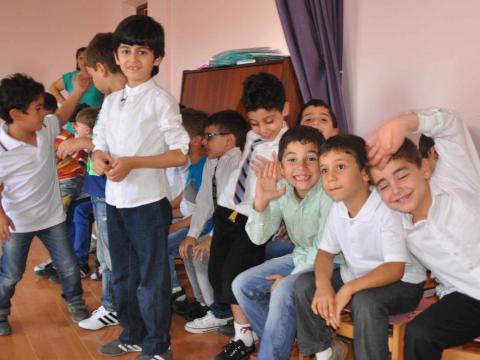Supporting well-being of Syrian-Armenian children

World Vision Armenia joined forces with the Ministry of Diaspora, the “Coordination Centre for Syrian-Armenians’ Issues”, UNICEF, and Save the Children to support social and psychological well-being of Syrian-Armenian children, who escaped to Armenia due to the Syrian civil war.
A number of activities have been implemented to help the children learn more about life in Armenia and support their integration into the Armenian society. World Vision Armenia in partnership with the Ministry of Diaspora, the “Coordination Centre for Syrian-Armenians’ Issues” NGO, UNICEF, and Save the Children initiated a project to support social and psychological well-being of Syrian-Armenian children. Some 300 students of Cilicia school, 60 preschool children and 19 teachers benefitted from this project.
A Memorandum of Understanding was signed in the beginning of July 2013, and a number of activities have been implemented since then to help Syrian-Armenian children learn more about life in Armenia and support their integration into the Armenian society. World Vision Switzerland provided funding for this project.
Many Syrian-Armenian families were severely affected by the escalating civil war in Syria and had to escape to Armenia, where they are facing numerous problems, such as unemployment, high rental prices and lack of money for food and clothing. It is estimated that there are approximately 8000 Syrian-Armenians in Armenia, including more than 1500 children. Having witnessed war crimes, being forced to leave the familiar place, friends and families, many children experience serious psychological problems and have difficulty adjusting to the new cultural and social environment.
A survey conducted by World Vision Armenia among Syrian-Armenian school teachers revealed that the majority of children, who arrived from Syria, experienced psychological problems related to adjustment to their new environment (67%) and emotional stress (53%). The children have difficulty adjusting to the life in Armenia due to the differences in language* and traditions, as well as certain stereotypes that exist in the society. At the same time, many of them know very little about Armenia’s life and culture.
“The lack of strong skills and abilities for quick adjustment in a new environment may lead to the continuous isolation of the children. Therefore, an immediate intervention program for their psycho-social rehabilitation was necessary,” says Gurgen Boshyan, Humanitarian and Emergency Affairs Expert of WV Armenia.
Based on the survey data, the World Vision’s partners developed methodological materials and implemented activities for building capacity of school teachers who work with Syrian-Armenian children.
The project partners also organised two-month summer classes for five to six year old children in order to better prepare them for school. World Vision provided didactic materials and transportation for the children and held psychosocial consultations for their parents.
“The classes were very efficient,” says Ani Chalian, the project deputy manager. The children learned numbers, letters and everything they need to be ready for school. In the beginning many had difficulty understanding Eastern Armenian. “Now the children not only understand it, but even speak without an accent. If they enter a regular local school, they will not have troubles studying or communicating with other children.”
As part of the joint project, 235 Syrian-Armenian children spent ten days at summer camps, including 55 boys and girls aged 10-17 who went to camp thanks to World Vision’s financial support. They enjoyed beautiful nature at the mountainous resort of Aghavnadzor and participated in educational activities, sports and games.
“I really enjoy this camp, and today we had a lot of fun,” says 10-year-old Cristine, who participated in a team challenge game organized by World Vision’s staff. “We also had interesting discussions about Armenian ancient and modern history, language and religion,” adds Angela, 16.
“We met many new people here, and made new friends,” says Lusy, a camp team leader. “The kids do not want this camp to end.”
*There are two major varieties of Armenian language: Eastern Armenian is mostly spoken in Armenia and Iran, and Western Armenian is spoken in Armenian communities in the United States, Europe, Middle East, Australia, and South America.